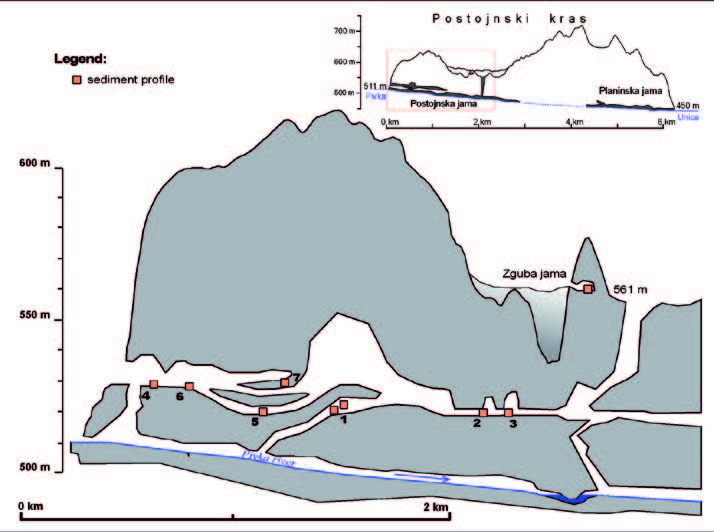Cave Sediments from Postojnska–Planinska Cave System (Slovenia): Evidence of Multi-Phase Evolution in Epiphreatic Zone
DOI:
https://doi.org/10.3986/ac.v37i1.160Povzetek
The Postojnska jama–Planinska jama cave system and number of smaller adjacent caves are developed in the Postojnski kras. These caves are located between two dextral strike-slip fault zones oriented in the Dinaric direction. The caves contain lithologically diversified cave fill, ranging from speleothems to allogenic fluvial sediments. The allogenic clastic material is derived from a single source, Eocene siliciclastics of the Pivka Basin. Small differences in mineral/petrologic composition between the sediments can be attributed to different degrees of weathering in the catchment area and homogenization of source sediments. Thick sequences of fine-grained laminated sediments, deposited from suspension are common. The depositional environment was mostly calm, but not completely stagnant. Sucha sedimentary environment can be described as cave lacustrine, withdeposition from pulsed flow. The homogeneity of the palaeomagnetic data suggests rapid deposition by a number of short-lived single-flood events over a few thousand years. This depositional style was favourable for recording of short-lived excursions in the palaeomagnetic field. The sediments were originally not expected to be older than Middle Quaternary in age (i.e. about 0.4 Ma). Later numerical dating (Th/U and ESR) indicated ages older than 0.53 ka. New palaeomagnetic data from selected sedimentary profiles within the cave system detected normal polarization in muchof the profiles studied. Reverse polarized magnetozones, interpreted mostly as short-lived excursions of magnetic field, were detected in only a few places. Therefore, we interpreted most of the sediments as being younger than 0.78 Ma, belonging to different depositional phases within the Brunhes chron. Palaeomagnetic properties of two profiles in caves intersected by the artificial tunnel between Postojnska jama and Črna jama had reverse polarized magnetozones and of sediments in Zguba jama, may indicate an age muchgreater than 0.78 Ma. The cave system has evolved over a long period of time, governed by the functioning of Planinsko polje in the relation to the evolution of the resurgence area in Ljubljana Moor further to the east. General stabilization of the hydrological system withlow hydraulic head led to the evolution of caves in epiphreatic and paragenetic conditions over a long time-span. Individual cave segments or passages were completely filled and exhumed several times during the evolution of the cave. Alternation of depositional and erosional phases may be connected withchanging conditions within the cave system, the functioning of the resurgence area, collapse, climatic change, tectonic movement and the intrinsic mechanisms of contact karst.Prenosi
Podatki o prenosih še niso na voljo.

Prenosi
Objavljeno
2008-06-01
Kako citirati
Zupan Hajna, N., Pruner, P., Mihevc, A., Schnabl, P., & Bosák, P. (2008). Cave Sediments from Postojnska–Planinska Cave System (Slovenia): Evidence of Multi-Phase Evolution in Epiphreatic Zone. Acta Carsologica, 37(1). https://doi.org/10.3986/ac.v37i1.160
Številka
Rubrike
Original papers
Licenca
Avtorji jamčijo, da je delo njihova avtorska stvaritev, da v njem niso kršene avtorske pravice tretjih oseb ali kake druge pravice. V primeru zahtevkov tretjih oseb se avtorji zavezujejo, da bodo varovali interese založnika ter da bodo povrnili morebitno škodo.
Podrobneje v rubriki: Prispevki




